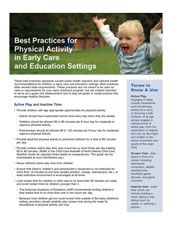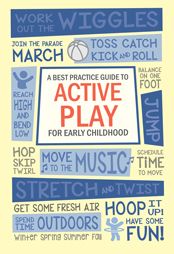Best Practices for Physical Activity
Best practices for physical activity in early care and education settings often exceed state requirements. These practices listed below are not requirements for your early childhood program. They are intended to serve as a guide and measurement tool to help set goals or create policies that encourage healthy lifestyles.
HAVE A QUESTION?
Contact a Health & Safety Consultant: 800-997-8515
Submit a question or request individualized support ➜
-
View/Download Printer-Friendly PDF
-
This guide is a companion to North Dakota’s Early Learning Guidelines. It offers practical ways parents, families, and early care and education (ECE) providers can encourage children, ages 2 to 5 years old, to engage in more physical activities. All information in this guide is based on current science, research and national best practices.
-
Check out our Physical Activities and Interest Area page for more active play ideas.
-
Promote Active Play Every Day
-
Choose age appropriate physical activities
- Infants should have supervised tummy time every day when they are awake.
- Toddlers should be allowed 60 to 90 minutes per 8 hour day for moderate to vigorous physical activity.
- Preschoolers should be allowed 90 to 120 minutes per 8 hour day for moderate vigorous physical activity. -
Provide pre-school children with adult-led activities
Provide 60 minutes of adult-led physical activity to preschool children daily.
-
Play outdoors every day
Provide outdoor active play time year-round two or more times per day totaling 60 to 90 minutes.Refer to Child Care Weather Chart to adjust times based on temperatures.
-
Never withhold active play time from children
-
Limit use of restricted environments
Ensure that infant’s, toddler’s and preschooler’s movement is not restricted for more than 15 minutes at one time (seated position, swings, exersaucers, etc.). A least restrictive environment is encouraged at all times.
-
Limit screen time
The American Academy of Pediatrics (AAP) recommends limiting children’s total media time to no more than one or two hours per day.
Because most children tend to get too much screen time outside of the early childhood setting, it is best practice to limit screen time for children in child care to no more than 30 minutes per week and avoid screen time for children younger than 2. -
The ChildcareAlive! curriculum contains 12 nutrition and physical activity lesson plans, intended for children ages 2–5 years old in early care and education settings. These lessons include:
- Basic nutrition education
- Simple cooking activities
- Sensory exploration of new foods
- Adult-led physical activity
-
Create Environments for Active Play
Always keep safety in mind when creating environments for active play.
-
Always consider safety when creating environments for active play.
-
Offer a variety of fixed play equipment
Make a wide variety of fixed play equipment available that accommodates the needs of all children.
-
Provide a variety of portable play equipment
Make a large variety of portable play equipment available for children to use at the same time.
-
Make outdoor equipment freely available
Make outdoor play equipment freely available to all children at all times and encourage turn taking.
-
Vary types of outdoor spaces
Outdoor play space should include open, grassy areas and an area for wheeled toys.
-
Make indoor play space for active play
Make indoor spaces available for all activities, including physical activity and movement.
-
Be an Active Role Model
-
Join in children's active play
Encourage children to be active by joining them in active play.
-
Provide visible support
Encourage physical activity though the use of posters, pictures, and displayed books.
-
Participate in On-Going Training
-
Learn more about active play & physical activity
Participate, and ensure staff participates, in training opportunities on physical activity (above and beyond playground safety) two times per year or more.
-
Share physical activity education to famiilies
Offer physical activity education opportunities (flyer, newsletter, family fun event, community event, etc.) to parents two times per year or more.
-
Create a Physical Activity Policy
-
Make a Written Commitment
Create a written policy on physical activity that is available to staff and parents and routinely followed, including items from the previous four physical activity key areas.



